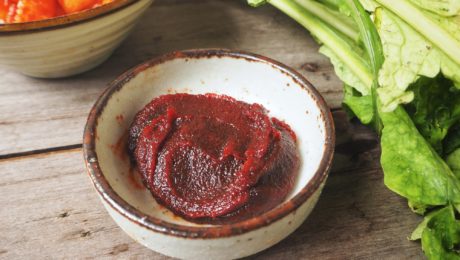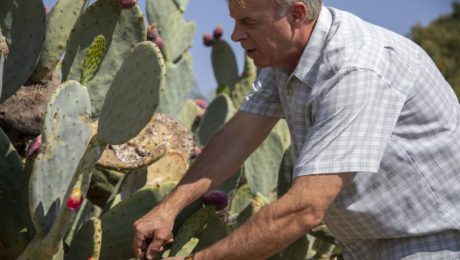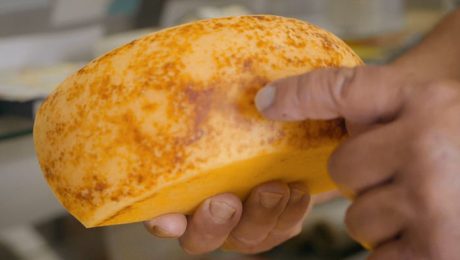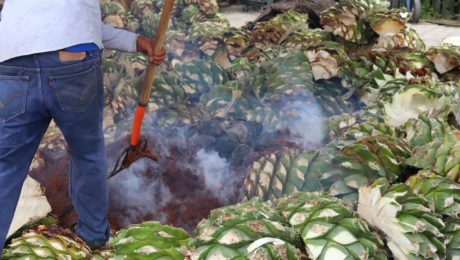The Gochujang Debate
The next “it” condiment in the U.S, gochujang is sweet and spicy, fermented for six to 12 months, and adding an umami tang. More restaurants are incorporating gochujang into their dishes, like the Shake Shack chain has done with their new Korean-Style Fried Chick’n sandwich.
But gochujang’s popularity has been a divisive issue. On one hand, many critics say mainstream food culture shouldn’t cherry-pick trends. “Ethnic foods, particularly the fermented variety, have a history of being typecast as unappetizing in the United States,” writes Hanna Park, the article author. She quotes Eric Kim, a food writer for The New York Times who says he hates that gochujang is now popular: “I never like to say a pantry ingredient is ‘trending’ or ‘mainstream,’ because that implies it is new. But new to whom? Gochujang is one of the oldest foodstuffs, beloved by millions of people for centuries.”
Meanwhile, other food experts say it’s wonderful to see Korean food used as inspiration for new dishes. Chef Hooni Kim, who owns Danji and Hanjan restaurants in New York City, says there was a time when Americans didn’t know anything about Korea, confusing it with China and Japan. Gochujang helps people appreciate Korea for its food culture. “It all comes down to execution. If they make it delicious, so people like Korean fried chicken or gochujang, then I thank them,” he said.
Read more (NBC News)
- Published in Food & Flavor
The Dodo of Gastronomic History
Scientists are working to recreate an ancient garum, considered the “dodo of gastronomic history.” Beloved by Mediterranean civilizations, the fish sauce was thought by historians to be extinct, lost along with the Roman Empire.
Food technicians got new insight into this garum when archaeologists discovered sealed dolia (large clay storage vessels) at what is believed to be a former Garum Shop at Pompeii. The eruption of Mount Vesuvius buried the building, preserving the factory. The charred, powdered remains left in the vessels — plus a fish sauce recipe believed to have been from the 3rd century A.D. — has aided food techs in recreating the ancient garum.
This product uses heavily salted small fish fermented for one week with dill, coriander, fennel and other dried herbs in a closed vessel. The resulting “Flor de Garum” is sold in Spain by the Matiz brand in amphora-shaped glass bottles.
Top chefs in Spain have been using Flor de Garum in new dishes. Mario Jiménez Córdoba, chef at El Faro in Cádiz, uses it in black-truffle ice cream, a raw sea bass dish and chocolate ganache.
“When people think of garum,” Jiménez says, “they imagine something that smells disgusting. But we have to think of garum like we would salt, or soy sauce. You use only a few drops, and the flavor is incredible.”
Read more (Smithsonian Magazine)
- Published in Food & Flavor, Science
Foraging for Cocktails
More restaurant owners are offering foraging tours for patrons, a farm-to-table experience where guests pick ingredients for their meal. The Los Angeles Times highlights Central Coast Distillery in Atascadero, Calif. They take visitors on a unique outing around San Luis Obispo County to learn about the “epicurean and medicinal qualities of botanicals.”
Distillery owner Eric Olson calls the tours “wildcrafting.” He shows guests how tequila is made, by roasting, mashing and fermenting local agave. He takes them through the hills of Paso Robles to pick prickly pears from nopal cactus, then collects bay laurel leaves, fennel, toyon berries and elderberry.
Guests are brought back to the distillery to create cocktails from their foraged goods. “I usually like to stick to the classics, but then put a personal little twist on them with something that we foraged,” Olson says.
Read more (Los Angeles Times)
- Published in Business, Food & Flavor
Brewing Health & Flavor with Kombucha
Alesia Miller wanted her Soul Brew Kombucha to introduce the health benefits of the fermented tea to Black people.
“Doing a little research about the industry, I learned there weren’t a lot of Black people or Black women brewing kombucha. It left out a lot of people – these cultures I felt needed to be educated on the benefits of it,” Miller tells Milwaukee Magazine.
The first kombucha brand in Milwaukee, Soul Brew found a niche with unique flavor combinations.These include Ginger Mango Peach, Cherry Bomb and a flavor called “Black Lives Matter” (a combination of Blackberry, Lemon and Mango).
Read more (Milwaukee Magazine)
- Published in Food & Flavor
FERMENTATION 2021 Wrap-Up
Nearly 300 individuals from around the world participated in The Fermentation Association’s first conference, FERMENTATION 2021. The virtual event included 35 educational keynotes, presentations, and panel discussions from more than 60 speakers over three days. Topics ranged from the science of fermentation to the art of fermenting to create flavor, from how fermented products are selling at retail to what’s next in the world of fermentation.
“I’ve been in this field for 40 years and, in all honesty, this is one of the biggest honors I’ve received, to be the speaker for this opening meeting of this really cool organization,” said Bob Hutkins, professor of food science at the University of Nebraska. Hutkins presented the conference’s opening keynote, Definition & History of Fermented Foods.
Over five years ago, John Gray, TFA’s founder, envisioned a trade show for producers of fermented foods and beverages, to make those artisanal items a more prominent part of the retail space. John connected with Neal Vitale, TFA Executive Director, and the organization was born out of their collective vision. TFA has grown, with a robust website, biweekly newsletter,a series of webinars and, now, an international conference. TFA has an Advisory Board that includes food and beverage producers, academics and researchers, and food and flavor educators and authors. TFA has formed working relationships with a number of other like-minded trade associations and organizations, and established a Buyers Council to create an active dialogue with food and beverage distributors, brokers and retailers.
“I have to tell you what a thrill it is to have you all here to witness and to participate in the beginning of a dream coming true,” added Gray in his welcoming remarks. Gray is the chairman and CEO of Katalina Holding Co., a food incubator and parent company of Bubbies Pickles.
FERMENTATION 2021 content paralleled TFA’s primary missions: first, help consumers better understand fermentation and its potential health benefits; second, work to improve health and safety regulations as they pertain to fermented products and third, connect the science and health research communities with producers, supporting scientific research and for a better understanding of the “state of the art.”
What made FERMENTATION 2021 unique is that it was the first event to bring together everyone involved in the world of fermentation — producers, retailers, chefs, scientists, authors, suppliers and regulators. The conference was not a how-to fermentation education event, as TFA feels there are numerous, effective resources for the person looking to, for example, make kimchi or learn about using koji.
“”We were delighted with how well FERMENTATION 2021 met — in fact, exceeded — our goals,” said Vitale. “While we were disappointed that the continuing impact of COVID-19 kept us from meeting in person, we were gratified by how all the participants responded, interacted, and engaged during our three jam-packed days. And, with recording of all our sessions now available online for our registrants, we expect that energy and excitement to continue.”,
“Fermentation is experiencing a major surge of interest in restaurants and kitchens around the globe,” says Amelia Nielson-Stowell, TFA Editor. “Our conference was a major milestone for the industry and we are already in the planning stages for FERMENTATION 2022 next summer. And, assuming we will be able to meet in person once again, we plan to host a tasting and sampling event for consumers alongside our conference.”
- Published in Business, Food & Flavor, Health, Science
Katz on Fermentation, Ancient & Modern
When Sandor Katz was asked to teach his first fermentation workshops in the early ‘90s, he figured it would have only niche appeal. Instead, people filled his workshops, begging for more information and calling on him to host similar events all over the U.S. “People [were] hungry for more information on fermentation,” he says.
“Humans didn’t invent fermentation. Fermentation is a natural phenomenon that existed before we did,” Katz says, speaking from in front of a wall of ferments and spices in his home kitchen in Tennessee. “Fermentation is an essential part of how people everywhere make effective use of whatever food resources are available to them. Food fermentation is not precious; fermentation is practical.”
Katz was a keynote speaker at the FERMENTATION 2021 conference. He shared his personal journey into the subject as well as his thoughts on fermentation as a natural phenomenon.
Fermentation as Trend
Katz says people are excited about fermentation for different reasons — some have memories of fermenting with their grandparents and want to try it at home, others are immigrants wanting to recreate dishes from their native countries, some are farmers hoping to preserve a surplus of produce, others are interested in the health benefits and some are foodies chasing the delicious flavor.
He hates equating fermentation with trends, preferring the term “fermentation revitalization” — the demographics of people currently making fermentation “trendy” again hasn’t really changed in the last 30 years.
“Fermentation has been so important to food traditions everywhere, and yet because of factory food production, one-stop shopping convenience foods, fewer and fewer people were practicing fermentation,” Katz said, recalling his workshops in the early days. “It was becoming more mysterious to people. Now there’s no denying that fermentation is trending. There’s a heightened awareness of fermentation, but people don’t realize the products of fermentation have been so integral to how everybody, everywhere eats. Without even thinking about fermentation, people have always been eating products of fermentation.”
The “War on Bacteria”
But there has long been fear around fermentation from some consumers. Katz says many people “project their anxiety about bacteria onto the idea of fermentation.”
“For people of my generation and older, we never heard anybody say anything positive about bacteria. The degree that bacteria were talked about at all, it was about how dangerous they are and how much they need to be avoided. I grew up in a period that could be described as the war on bacteria, this idea that bacteria are pathogenic, bacteria are dangerous to us, bacteria must be avoided and you know we have an arsenal of chemicals that we can use to kill bacteria as needed to keep us safe.”
The U.S Department of Agriculture has never had a case of foodborne illness from fermented food or beverages, Katz notes. “Statistically speaking, fermented vegetables are safer than raw vegetables.”
Facing people’s questions and fears motivated Katz to write his first book, The Art of Fermentation. This month, he released his 6th title, Fermentation Journeys: Recipes, Techniques, and Traditions from Around the World.
Fermenting the Future
Katz is an advocate for decentralizing food production, replacing a global supply chain with local, farm-fresh sources. Though this will raise the cost of food, it will put fermentation as a key means of preserving a surplus of seasonal crops, Katz notes.
Even as more and more chefs and producers apply different processes to different substrates and play with flavor, Katz says the fundamental processes remain the same. Nothing new has been invented in fermentation, which dates back 10,000 years.
“Fermentation of the future grows out of the techniques and traditions of the past,” he says. “Anything you can possibly eat can be fermented, so I’m never surprised when something is fermented.”
Katz shared his story of fermenting a goat on the rural Tennessee farm he lived on in the ‘90s. After the animal was butchered, he took the leftover pieces and fermented them for a few weeks in a mix of miso, yogurt and sauerkraut juice. When cooked, the meat released a strong aroma, a scent that became legendary on the farm. But, Katz says, “It was delicious. Like many things, it had a stronger aroma than flavor.”
Health Benefits Come with Warning Labels
When asked about the curative health benefits of fermented foods, Katz does not mince words. He wrote in Wild Fermentation that fermented foods were an important part of his healing when he was diagnosed with HIV in 1991. Since then, numerous media outlets have twisted his story, writing that Katz cured himself from HIV with fermented foods.
“I have become much more cautious about how I talk about this,” he says. “There’s a lot of highly speculative information out there…and I’ve never seen data that would suggest that.”
Katz says he’s careful to rely on reputable scientific studies for data on fermentation’s health benefits. He says he’s read articles claiming kombucha will prevent hair from going gray. Pointing to his full head of gray hair, Katz smiles and says “When I started teaching about fermentation, my hair didn’t look like this. Time marches on.”
“Food has profound implications for our health and well-being and for how we feel, but singular foods are very rarely the cure to specific diseases. …There are many benefits to fermentation, whether it is simply from pre-digestion of nutrients that makes nutrients more bioavailable and accessible to us or whether it’s from the probiotics or whether it’s from metabolic byproducts which can be extraordinarily beneficial to us.”
- Published in Food & Flavor
Food Technology’s “Gut Feeling”
Food Technology’s latest issue features an article entitled “Not Just A Gut Feeling” which details how and why more consumers are buying and making fermented foods and drinks. Spurred by the Covid-19 pandemic, there is growing interest in the gut microbiome and healthier food options.The curiosity around fermentation is buoying the retail category.
“It checks off all the boxes — artisanal, local, natural, sustainable, innovative,” says Bob Hutkins, food science professor of food science at the University of Nebraska–Lincoln (and a recent addition to TFA’s Advisory Board.) “People are making sourdoughs at home; they’re making kimchi at home; they’re going to kombucha bars. It’s definitely got the Gen Xers and the millennials intrigued.”
Included in the article are many insights from TFA — Advisory Board members Alex Lewin and Kheedim Oh, Executive Director Neal Vitale, and Editor Amelia Nielson-Stowell are all quoted.
Read more (Food Technology Magazine)
- Published in Business, Food & Flavor
Fermenting Coffee with Koji?
A two-time Finnish Barista Champion made headlines with his unique cup of joe at the World Barista Championship in Italy — a koji-fermented coffee.
Aiming to make better coffee than what’s available on the market, Kaapo Paavolainen (pictured) studied how he could maximize the flavor in coffee beans. “Sugar in beans is responsible for coffee’s inherent sweetness but the lack of it results in unpleasant bitterness. But the current methods can extract only 70% of available sugar,” he told Forbes.
After reading about koji in the books Koji Alchemy (by Jeremy Umansky and Rich Shih) and The Noma Guide to Fermentation (by Rene Redzepi and David Zilber), he realized koji can tap into the remaining 30% of sugar in beans.
Incredibly, this koji-based method was used on subpar coffee beans in experiments and still transformed the coffee. Umansky described the flavor as “deep, earthy and leathery. Depending on the roasting level of the beans, the flavor ranged widely from tropical fruits like pineapple and mango to chocolate and gingerbread. The mouthfeel was strikingly silky and luxurious like butter. The rounded, full-bodied texture made these tastes last very long.”
Paavolainen aims to scale the koji process with a partner farm in Columbia. This new coffee method could aid coffee farmers, many of whom are financially challenged and are struggling to maintain farms in the face of climate change.
Read more (Forbes)
- Published in Business, Food & Flavor
The São Jorge Cheese
On the remote, volcanic island of São Jorge in the middle of the Atlantic is what Insider calls “Portugal’s best-kept secret” — its eponymous cheese.
The weather conditions on the island make it perfect for cheesemaking, an art that began there 500 years ago. It’s humid, so cheese can rest at room temperature, packing the cheese with moisture. Cows (there are over 10,000 on the island, double the number of the human inhabitants) can graze year round.
São Jorge cheese is rich, with “hints of spiciness, and a grassy scent.” One of four dairy farmers on the island, João, ascribes the flavor to the cheesemaking process, which preserves “the flavors of the island in the cheese by not killing the native cultures that are present in the milk.” The milk is kept raw, unpasteurized and whey from the day before is used to ferment the milk instead of adding fermenting agents.
Read more (Insider)
- Published in Food & Flavor
Analyzing Mexico’s Traditional Fermented Beverages
A research team has made the first comprehensive analysis of Mexico’s traditional ferments. Utilizing the country’s native cacti, agaves and maize, these diverse beverages are unique to their region. But they are poorly studied, and some are endangered as they fall out of style with younger generations.
“Many of Mexico’s finest microbiologists and ethnobotanists are giving ever-greater attention to this fascinating but once-forgotten foodscape, but even they are willing to admit that we’re just beginning to scratch below the surface of understanding all the biodiversity in these bottles of blessed ferment,” says Gary Paul Nabhan, research scientist at the Southwest Center of the University of Arizona (U of A).
Researchers in various disciplines (microbiology, ethnoecology and genetics) from five different schools (U of A and four universities in Mexico) took part in the study. The results, Traditional Fermented Beverages of Mexico: A Biocultural Unseen Foodscape, are published in the international journal Foods.
Sixteen traditional Mexican fermented beverages were identified: tepache, pulque, hobo, Mexican wines, colonche, nawait, pozol, sidra, tejuino, tesgüino, taberna, cocoyol, tuba, Mexican palm wine, balché and xtabentún. Those 16 drinks were made from 143 plant species and include 102 genre of microorganisms.
In each region, “a distinctive set of plant roots, leaves, fruits and stems were added as fermentation catalysts, flavorants, colorants and stabilizers,” reads the U of A press release. “A large number of bacterial strains and yeasts — in addition to common brewer’s yeasts and water kefir grains — enabled the nutritional transformation of these raw materials into a wide array of unique nutritionally rich, probiotic beverages.” The team mapped the regional variations and ecological niches of the fermented drinks.
Sustainable Future
The study notes this level of analysis is “indispensable” to promote fair trade and sustainable food production. Industrial mezcal, for example, has created a monoculture of blue agave, and farm labor often works in exploitative conditions.
“These products have been embedded as part of the daily lives of many people, including those currently marginalized rural or Indigenous groups,” the study reads. “The diversity of fermented products is an outstanding reservoir of genetic resources that has high potential to obtain secondary products such as extracts, enzymes, dyes, and others compound that can be involved in global markets and could help to solve problems such as hunger and poverty and may play a key role to reinforce cultural identity..”
Traditional Mexican fermented beverages also provide important nutrients for consumers as the globe battles a changing climate.“The naturally-occurring yeasts and kefir-like tibico grains found in association with prickly pear cacti, saguaro fruit, century plants and desert spoons (sotols) likely tolerate much higher ambient temperatures than those from the semi-arid highlands and wet tropical forests,” Nabhan explains.
Extinct Drinks
Some healthier artisanal drinks “have fallen out of fashion and face local or broad extinction,” the press release notes. In some areas of the country, these “forgotten ferments” are still used in the home, but not commercialized.
“Now that the days of Prohibition are over and there is a great need for arid-adapted crops with highly-efficient water use, some of these traditional agave and cactus varieties should be revived for the local production of healthful beverages,” Nabhan suggests. “In fact, traditional beverages such as tepache, tesguino and colonche have made a comeback in the Tucson, Arizona, region since it received recognition as a UNESCO City of Gastronomy. These traditional beverages are also being employed by mixologists in novel cocktails now being featured in nearly every state of Mexico.
- Published in Food & Flavor, Science










